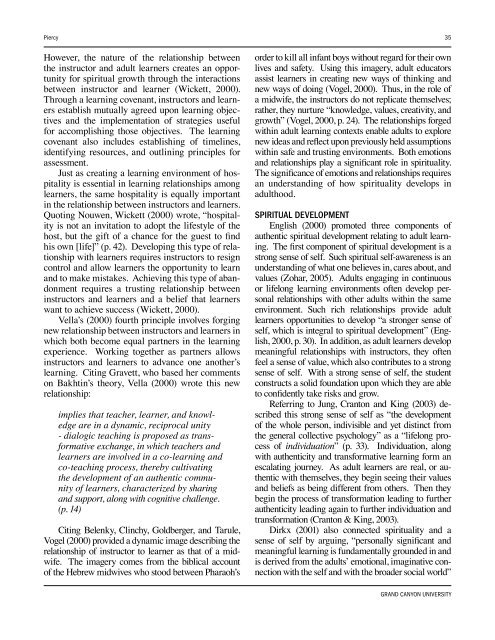The Gift of Spirituality
The Gift of Spirituality
The Gift of Spirituality
Create successful ePaper yourself
Turn your PDF publications into a flip-book with our unique Google optimized e-Paper software.
Piercy 33<br />
Within the brain, chemical transmissions continuously<br />
and simultaneously process information<br />
from both conscious and unconscious sources<br />
(Merriam & Caffarella, 1999). This information<br />
within the brain travels from one neuron to the next<br />
neuron through chemical molecules known as neurotransmitters<br />
that move information throughout<br />
the brain through an intricate and multifaceted system.<br />
Consequently, human feelings, emotions, and<br />
reason continually interact within the brain as the<br />
neurotransmitters deliver information throughout<br />
the brain. For example, one might have to make a<br />
decision with regard to relocating to a new city for<br />
a new employment opportunity. As the process <strong>of</strong><br />
evaluating the situation takes place, the individual<br />
considers the job and the location <strong>of</strong> the job, which<br />
could elicit specific feelings. If the emotional attachment<br />
to the city is positive, the individual might<br />
have euphoric feelings resulting in a smile. If the<br />
emotional attachment to the city were negative, the<br />
feelings would be the opposite. Thus, emotions are<br />
influential in the cognitive process (Taylor, 2001)<br />
Goleman (2006) affirmed the relationship between<br />
the cognitive and the emotional noting that<br />
humans have a rational mind (thinking) and an<br />
emotional mind (feeling) which interacts to create<br />
the mental life. Citing Merriam and Caffarella and<br />
Taylor, Dirkx (2001) supported these findings by<br />
noting that,<br />
‘Brain-based’ theories and the concept<br />
<strong>of</strong> ‘emotional intelligence’ suggest that<br />
emotion and feelings are deeply interrelated<br />
with perceiving and processing information<br />
from our external environments, storing<br />
and retrieving information in memory,<br />
reasoning, and the embodiment <strong>of</strong><br />
learning. (p. 68)<br />
Citing Johnson-Laird and Oatley, Taylor (2001) wrote,<br />
Without emotions, individuals are unable<br />
to co-ordinate their behavior, respond to<br />
emergencies, prioritize goals, prepare for<br />
proper action and make progress towards<br />
goals – incapable <strong>of</strong> filling the gaps <strong>of</strong>ten<br />
found in the slow and error-prone process<br />
<strong>of</strong> objective rationality. (p. 223)<br />
<strong>The</strong> emotional dimension <strong>of</strong> human nature<br />
serves as an important component <strong>of</strong> the learning<br />
process as both emotions and reason interrelate in<br />
order to promote learning. In addition, emotions<br />
<strong>of</strong>ten serve as the catalyst for reflection as adults begin<br />
exploring their feelings leading toward transformative<br />
learning. Barlas (2001) found that “intense<br />
emotional content <strong>of</strong> learning experiences served…<br />
to trigger reflective learning by directing focus on<br />
assumptions that underlie frames <strong>of</strong> reference” (p.<br />
4). Barlas’ research was in the context <strong>of</strong> learningwithin-relationship,<br />
which is a second aspect <strong>of</strong><br />
spirituality.<br />
Relationships<br />
Recalling the various definitions <strong>of</strong> spirituality,<br />
one definition worth revisiting is the idea <strong>of</strong> the<br />
interconnectedness <strong>of</strong> all people as relationships<br />
among adult learners is vital to the learning process<br />
(Merriam & Caffarella, 1999). Adults entering into<br />
various learning environments <strong>of</strong>ten find camaraderie<br />
with other adult learners as helpful and stimulating.<br />
Encouraging, supportive, and trusting learning<br />
environments are indispensable for reasonable<br />
discourse. Nouwen described this as a hospitable<br />
environment in which people become friends (as<br />
cited in Wickett, 2000). As adult learners begin<br />
sharing their lives and experiences with one another,<br />
they may create a context <strong>of</strong> compassion and<br />
trust, through which they are able to discuss differing<br />
perspectives on topics <strong>of</strong> interest. This type <strong>of</strong><br />
safe environment provides opportunities for learners<br />
to examine the strengths and weaknesses <strong>of</strong><br />
their personal frames <strong>of</strong> reference, as well as those<br />
<strong>of</strong> others.<br />
Another benefit <strong>of</strong> a safe and trusting learning<br />
environment is that it allows for a sense <strong>of</strong> unity in<br />
diversity. <strong>The</strong> diversity <strong>of</strong> perspectives among adult<br />
learners within a given context serves to provide<br />
differing approaches and opinions that enrich the<br />
learning experience for everyone. Though engaging<br />
in discourse with those <strong>of</strong> differing perspectives<br />
may cause some adult learners to feel uncomfortable,<br />
establishing a safe and trusting learning environment<br />
enables adults to participate in the learning<br />
experience regardless <strong>of</strong> their feelings. <strong>The</strong>se<br />
safe and trusting environments <strong>of</strong>fer occasions for<br />
uninhibited and genuine dialogue, enabling adults<br />
to achieve superior meaning-making opportunities,<br />
which enables spiritual development. This learn-<br />
grand canyon university

















